An I/O device error occurs when Windows is unable to perform an input/output action, such as reading or writing the hard drive. Under this circumstance, Windows users are unable to access their hard drives and receive the I/O device error message. Let's see a real example from the forum.
I installed Windows 10 yesterday - and although I was able to read one file with my external Seagate Drive - it then stopped working and I get a "Cannot access a folder due to I/O device error".
In addition to the external hard drive, an I/O device error can occur on various devices, including hard drives, USBs, SD cards, etc. It's also reported to happen on multiple Windows versions such as Windows 7/8/10/11. To help you solve this issue and access your drive, this post covers 9 working solutions on how to fix I/O device error in Windows, along with clear explanations of why I/O device error occurs.
Here's an overview of the 9 best solutions and the corresponding situations.
| Solutions | Applicable scenarios |
| Check the cables are working | Cables are loose or weakened |
| Ensure all the cords are working | Cord connections are poor |
| Clean boot the Windows | Trouble background program with the computer |
| Clean Virus & Malware | Attacked situation by a virus |
| Change hard drive transfer mode | The transfer mode of the disk is incorrect |
| Check and repair hard drives in the command prompt | The disk has some errors |
| Upgrade or reinstall the driver | The disk driver is outdated |
| Change the drive letter | Drive letter conflict during initializing the device |
| Format the Hard Drive | The hard drive is incompatible with the computer |
Prepare to fix I/O device errors in Windows
When the system prompts with the I/O device errors, it's likely your drive is corrupted. In this situation, some of your data might be lost.
What's more, when you proceed with methods on how to fix the I/O device error, changes made to the drive may cause data loss or data to be overwritten. And that's why data recovery becomes the top priority.
Be Ready: Recover data from inaccessible hard drives
To recover data from hard drives with the I/O device error, you need a reliable and powerful hard drive recovery tool. Here, we insist you use iBoysoft Data Recovery, a capable Windows data recovery tool that's equipped with advanced disk scanning and recovery algorithms. It can recover lost photos, documents, videos, and audio on your internal and external hard drives.
Additionally, iBoysoft Data Recovery for Windows covers various data loss scenarios such as a system crash, software malfunction, virus infection, etc. It's also capable of recovering lost data from inaccessible, corrupted, RAW, and BitLocker encrypted drives.
Here is how to recover all your data without data loss before fixing I/O device errors:
Step 1. Free download, install, and launch the best hard drive recovery - iBoysoft Data Recovery for Windows on your computer.
Step 2. Choose the Data Recovery mode from the main interface. You'll be guided to all detected drives. Select the one that reports the I/O device error. Tick the box in front of the Deep scan option in the bottom-left corner before clicking on Next.
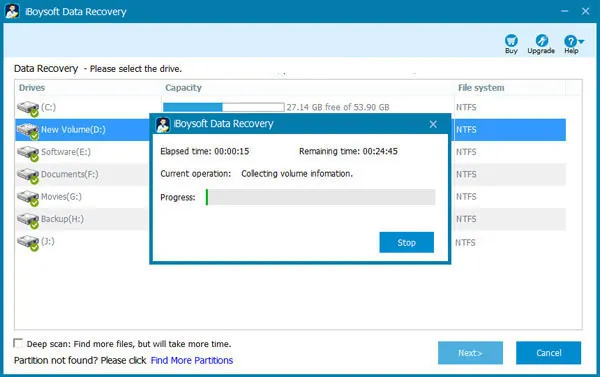
Step 3. Wait for the scanning results. Then you can filter and preview desired files. Select the files you want to restore and tap on the Recover button. You're required to save the recovered files in a new location.
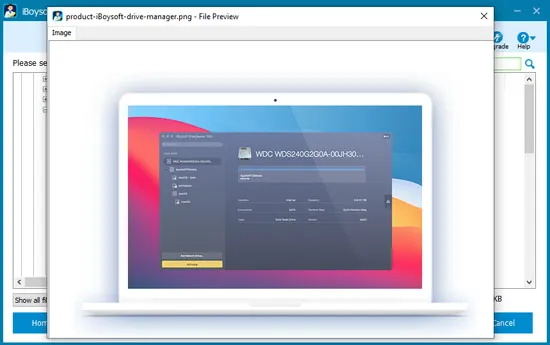
How to fix hard drive I/O device errors in Windows (9 Fixes)
The fixes to I/O device errors in Windows can range from the hardware level to software-related issues. After you have recovered your data to another safe location, it's time to fix the "the request could not be performed I/O error".It's suggested to find the appropriate fix when troubleshooting I/O device errors in Windows 7/8/10/11.
Fix 1: Check the cables are working
Broken, loose, and unstable cables are a major cause of I/O device errors. So, make sure every cable is tightly connected to the computer and the external storage media.
Moreover, you can try connecting the external hard drive to a different port or using a different cable to see if the issue lies in the connection.
Hopefully, you can easily solve the external hard drive I/O device error without moving forward.
Fix 2: Ensure all the cords are working
The next simplest method for solving I/O errors on an external drive involves addressing cord crosstalk. Because electrical signals from one set of wires have a tendency to seep into another set of cables, potentially causing disruptions to the connection during input-output operations.
- Disconnect all extra devices on your computer except for the external hard drive and essential accessories. (Permanently avoiding this problem can be achieved by swapping out the existing cables with higher-quality ones. )
- Additionally, you can connect your external drive to a different system to assess whether the cord is defective or if there's an issue with the external drive itself.
Fix 3: Clean boot the Windows
By performing a clean boot of the computer, you can verify whether the driver is conflicting with the external hard drive. If the I/O device error is fixed after a clean boot, your computer might contain an incompatible driver.
Note: Regarding the security of your computer, do not disable advanced boot options while performing the following procedures.
- Search for MSConfig in the Start menu and hit Enter. The System Configuration App will launch automatically.

- Go to Administrations > Hide all Microsoft administrations > Disable all.
- Next, move to the Startup tab and tap on the Open Task Manager option.
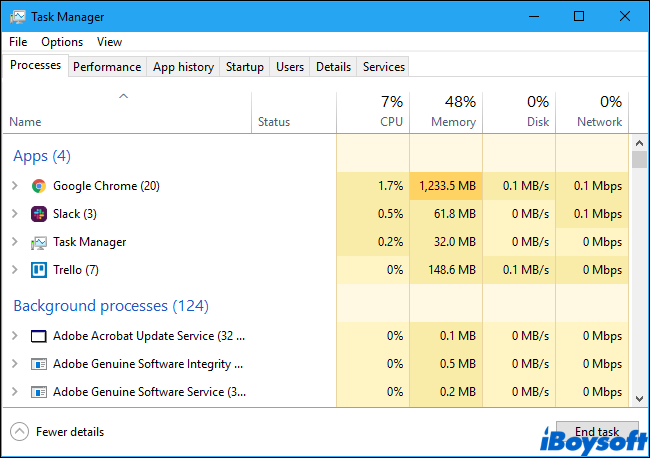
- Choose every startup item and select Disable. Quit Task Manager then.
- Return to the System Configuration window once more. After clicking Startup > OK, restart your computer.
Fix 4: Clean virus & malware
In certain situations, conducting a virus scan can potentially aid in resolving an I/O device error on an external hard drive. Here are the steps you can take:
- Connect the external hard drive to your computer.
- Enter virus into the search bar and launch the Virus & Threat Protection tool. Alternatively, you can utilize other virus-scanning software that is installed on your computer.
- Initiate the virus scanning process and wait for it to finish.
- Reboot your computer and reconnect the external hard drive to check if the issue has been resolved.
Fix 5: Change hard drive transfer mode
If the transfer mode is set incorrectly, the OS cannot transfer data from the disk to the computer and therefore prompts with the I/O device error. Follow the tutorial below to change the transfer mode of your hard drive.
- Open Device Manager > Find and expand IDE ATA/ATAPI controllers. A list includes various IDE ATA/ATAPI channels will appear.
- Typically, the channel for your external hard drive is named the Secondary IDE channel. Right-click on it and click Properties from the context menu.
- Navigate to Advanced Settings > device 0 > transfer mode box > PIO Only. Click OK and quit Device Manager.
Fix 6: Check and repair hard drives with command prompt
Windows users can check the file system and any logical or physical problems of the drive by using the command CHKDSK. The CHKDSK command can also fix logical problems and restore a correct file system when running with prompts like /F or /R.
You may refer to the article below to see how to fix the I/O device error by using chkdsk command lines.

CHKDSK /F or /R, Which One Is Better for Disk Check & Repair
This guide introduces the differences between CHKDSK /F and CHKDSK /R and tells you when and how to run them to check and repair hard drive errors and what to do when CHKDSK fails to run. Read more >>
Note: While performing chkdsk on the hard drive to check disk errors, if the system finds any bad sectors and is attempting to repair that sector, the data stored on that sector might be lost. In case that happens, you should use iBoysoft Data Recovery for Windows to recover data from the faulty drive first.
Fix 7: Upgrade or reinstall the driver
Occasionally, an I/O device error can be caused by an outdated driver. You can resolve the I/O device error by either upgrading or reinstalling the driver on your Windows PC.
- 1. Guide on updating the driver
- Navigate to Settings > Update & Security > Windows Update > Check for updates > View optional updates.
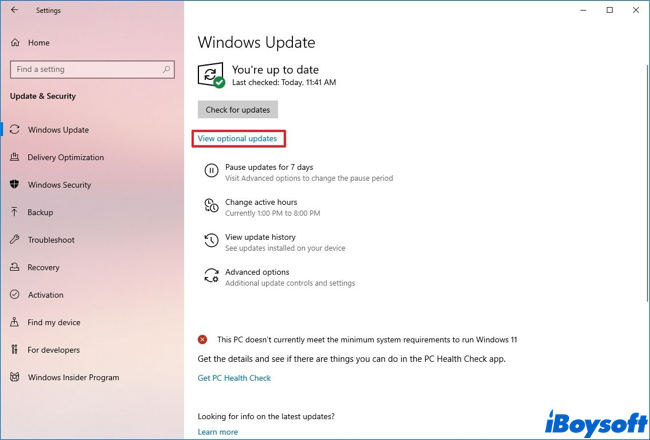
- Select the Driver updates tab > choose the device driver to update on your Windows PC.
- Click on the Download and install button to start upgrading the device driver.
2. Guide on reinstalling the driver
- Navigate to Device Manager by searching it in the toolbar.
- Right-click on the hard drive with the I/O device error. In the menu list, click on Uninstall device.
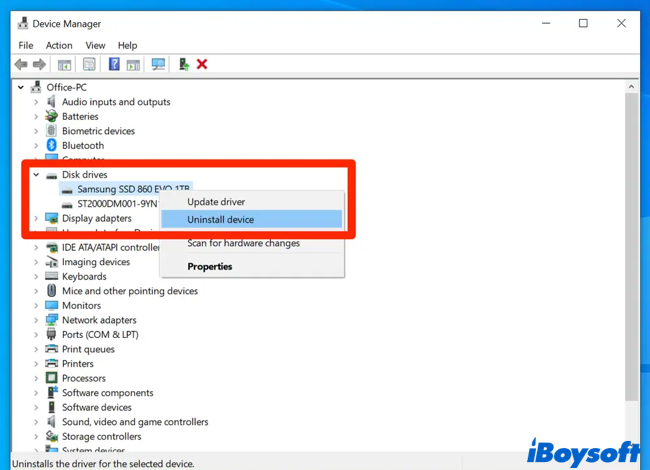
- Restart your computer and Windows will automatically reinstall the device driver.
Fix 8: Change the drive letter
An I/O error can occur if your system misreads or misidentifies the drive letter for an external hard disk. To resolve this I/O device error, you can simply modify the drive letter. Here's the procedure to change your drive letter:
- Right-click Start and select Disk Management.
- Within the Disk Management window, right-click on the volume for which you wish to alter the drive letter, then choose Change Drive Letter and Paths.
- To modify the drive letter, click Change and then pick your desired drive letter from the available list. A prompt may appear, warning you about potential issues with programs reliant on drive letters.
- In response to this message, select Yes to apply the changes.
Fix 9: Format the hard drive
If none of the previously mentioned solutions prove effective, you can consider formatting your hard drive. If you are unsure about how to format a hard drive easily, you must ensure you recovered and backuped all the data with iBoysoft Data Recovery for Windows. Or you will lose all after formatting.
( If formatting also proves ineffective, it is likely that your drive is severely damaged. In such a scenario, your only recourse would be to replace it with a new one.)
You can now test if the I/O device error is fixed. Share these methods if one of them works.
What causes I/O device errors in Windows 10?
After fixing the I/O device error with the above methods, you should successfully get rid of the error. We can get back to the topic now and dive in to see what causes the I/O device error or "the request could not be performed I/O error".
- The connection between the external hard drive and your PC is wrong. As a result, the attached device cannot be detected by your PC.
- The USB port on the computer or the USB card reader you use is faulty or damaged.
- The device driver is out-of-date or incompatible with the external hard drive.
- The USB device, memory card, or external hard drive you attempt to access is physically broken.
- Windows uses a transfer mode that is incompatible with your hardware.
Share these solutions to fix I/O device errors on Windows 7/8/10/11.
Conclusion
The I/O device error prevents you from reading or writing to the internal or external hard drive on Windows 7/8/10/11. Regardless of the multiple reasons that cause this hard drive error, this post elaborates on 9 working solutions to solve the issue. In case you have any questions, don't hesitate to leave a comment below!
FAQs about I/O device errors in Windows
- QHow do I fix I/O error on Windows 10?
-
A
There are several ways to fix I/O device error on Windows 10. One solution is to check all cable connections. Another is to update or reinstall the drivers. You can also run the chkdsk command prompt to repair corrupted hard drives.
- QWhat is an I/O device error?
-
A
An I/O device error is a problem that occurs when Windows fails to access a device such as an external hard drive, USB, SD card, etc. This can happen due to hardware problems or software-related issues.
